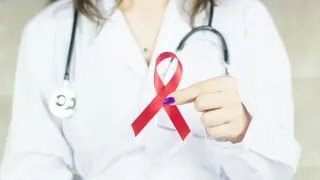
Dec 26
Chest Binder Companies Push Back Against FDA Warnings: 'This Is Clearly Discrimination'
READ TIME: 2 MIN.
On December 16, 2025, the U.S. Food and Drug Administration sent warning letters to at least 12 companies marketing chest binders, products commonly used by transgender and non-binary individuals to flatten the chest and alleviate gender dysphoria. The agency classified these binders as medical devices under section 201 of the Federal Food, Drug, and Cosmetic Act because they are promoted for affecting body structure or treating conditions like dysphoria. Specific examples include letters to For Them, Inc. , which sells products like "Jock Top" and "Binder Max," citing website claims such as "How to manage chest dysphoria & practice safe binding." Similar notices went to TomboyX, PBC for items like "Compression Top - Black," referencing statements about use by "individuals who identify as transgender, non-binary, or gender-fluid." Other recipients included GenderBender LLC and Early to Bed, Inc.
The FDA required these firms to register as medical device manufacturers under section 510 of the Act and cease unapproved marketing, warning of further enforcement if unmet. FDA Commissioner Marty Makary highlighted risks during a December 18, 2025, Department of Health and Human Services press conference, stating long-term use is linked to pain, compromised lung function, and breastfeeding difficulties.
Chest binder companies swiftly condemned the FDA's actions as overreach and discrimination. For Them, Inc. founder Chloe Freeman described the warning as "absurd," arguing it endangers transgender people by restricting safe binding options. Freeman emphasized that their products are designed to prevent harm from unsafe alternatives like tape or ACE bandages, which can cause rib injuries. TomboyX representatives echoed this, calling the classification a barrier to gender-affirming care. GenderBender LLC highlighted their binders' role in the LGBTQ+ community for gender euphoria and post-top surgery use.
Industry voices framed the warnings as part of a broader regulatory crackdown under HHS Secretary Robert F. Kennedy Jr., who linked it to curbing interventions for minors. Vendors argued this ignores medical guidance where binding is deemed safe.
Transgender advocates view chest binders as essential for mental health, helping manage dysphoria—a distress from mismatch between gender identity and body. Organizations stress safe binders reduce risks compared to improvised methods. Critics like Makary focus on youth harms, but physicians note supervised use minimizes issues.
This follows HHS's report on pediatric gender-affirming care, proposing limits. Companies must now respond to the FDA, potentially registering products or altering marketing, balancing compliance with accessibility for transgender and non-binary people. The debate underscores ongoing conflicts over regulating gender-affirming tools.






